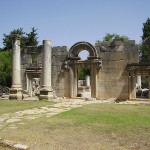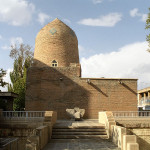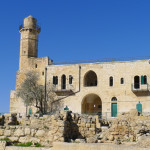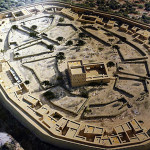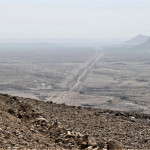Trip to Israel and Palestine, March 4—12, 2017
Spring has entered its rights, birds are loud and active in the city’s parks, rejoicing at the sun and the thaw’s drip-drop, and that means it is time now to get ready for another journey after new impressions. This time the choice fell upon Israel and Palestine.
In the trip’s program:
- Excursion to Bar’am National Park. Visiting the ancient Hebrew town of Gush Halav, Jish, and a Maronite village of Bar’am, situated on the territory of the National Park.
The chief attraction of the Bar’am National Park is the remains of a synagogue of the 2nd century A.D., one of the most well-preserved ancient synagogues in Israel. Among the ruins of the synagogue, the scientists found two inscriptions in Hebrew, “Elazar bar Yodan built it,” and “Peace be upon this place, and on all the places, where His people, Israel, dwell. Yose the Levite, bar (son of) Levi built this lintel. May blessing come upon his works. Amen.” The well-preserved facade has beautiful carved doors decorated with stone engravings, faced towards Jerusalem. Near it, there was another synagogue, occupying lesser space, which was ruined in the 19th century. Along with other archaeological finds, these prove the fact that a Jewish community lived here in the 2nd—4th centuries A.D.
According to the data of 2010, the population of Jish community was close to three thousand people, out of whom 99,8% were Arabs. As for the confessional status, among them: Muslims are 35,9%, and Maronite Christians are 63,9%. This is the only village in Israel, where the Maronites are the majority.
The Maronites belong to the Catholics of the Eastern rite. They speak Arabic, the main language of their worship services is Aramaic. Traditionally, Maronites are associated with Lebanese Arabs, but some Maronite ideologists deny the Arab identity of Maronites, indicating their Phoenician ancestry. The ethnonym Maronites comes from the name of the spiritual centre of Monothelits — the Monastery of Saint Maroun on the Orontes River , which was founded in the 5th century; according to another version — from the name of the first patriarch of the Maronite church Youhana (John) Maroun, who lived in the 7th—8th centuries.Посещение дубового леса, расположенного в Галилее вдоль северной границы
- Visiting an oak grove, which is situated in Galilee along the northern border of Israel with Lebanon, close to Kfar Bar’am community, where according to the tradition, which emerged in the Middle Ages, the tomb of Esther and Mordechai is located.
In reality, Esther’s and Mordechai’s tomb is located in the Iranian city of Hamadan, which was known in the ancient days as Ecbatana. The tomb is erected on the site, where, according to the tradition, the Biblical queen Esther was buried together with her cousin Mordechai. The monument is actually a tombstone and a hall built around the tomb. Throughout many centuries, the tomb has been an important place of pilgrimage for the Iranian Jews.
- Visiting Nebi Samuel Park and the tomb of Biblical prophet Samuel.
Prophet Samuel was the fifteenth and the last judge of Israel, who lived 1146 years before Christ. Samuel was from the tribe of Levi, he was the son of Elkanah from Ramathaim-Zophim, Mount Hermon.
Prophet Samuel’s tomb is located 885 metres above sea level, on the top of the Nebi Samuel Mount. As early as in the Byzantine period, Mount Nebi Samuel is mentioned as the burial site of prophet Samuel, contrary to the reference in the Bible, where it says that he was buried in his own house in Ramah, “And Samuel died; and all the Israelites were gathered together, and lamented him, and buried him in his house at Ramah.” (1 Samuel 25:1). Starting from the Middle Ages, Mount Nebi Samuel was acknowledged as the place of burial of the Jewish prophet. Today many Jews visit this place, especially on April 25 — the date of prophet Samuel’s death.
- Tour of one of the oldest cities of the world — Jerusalem, visiting the Eastern Wall of Jerusalem’s Temple (The Wailing Wall). Visiting the Armenian quarter of Jerusalem, and attending a worshipping service in Saint James’ Cathedral.
The Cathedral of Saint James in Jerusalem was built in the 12th century on the ruins of a Byzantine church. The cathedral is dedicated to two saints named James — apostle James, son of Zebedee, and James, a brother of Jesus Christ.
Apostle James, son of Zebedee, and his younger brother John (the Evangelist) were fishermen, and Jesus Himself called them to be His disciples. James, John, and Peter were the three closest disciples of Jesus Christ. James preached Christianity in Spain and in other European countries; then he came back to Jerusalem, where in 44 A.D., he was executed by Herod Antipas, who persecuted early Christians. The cathedral of Saint James in Jerusalem is built upon the site of the execution of Apostle James, son of Zebedee. The cut head of the apostle is kept in the cathedral, while his body rests in the Spanish town of Santiago de Compostela. Apostle James is also called James the Greater, to distinguish him from James the Lesser, a brother of Jesus Christ.
The Cathedral of Saint James is the chief Armenian church of Jerusalem. The Cathedral is decorated with sculptures, icons, and other religious symbols. Many lamps are attached to the cathedral’s ceiling. There are three altars in the cathedral. The central altar — the highest one — is dedicated to Saint James, the one on the right — to John the Baptist, and the one on the left — to Virgin Mary. Not far from the altars there are two thrones. One is for the Armenian Patriarch, and the other one, which is richer decorated, — for the spirit of Saint James. In the cathedral’s inner yard there is a sonorous wooden board (nakus), which the monks struck, calling for the worship service. Under the Muslims’ dominion in Jerusalem, Christians were forbidden from ringing the bells. In memory of those days, in the cathedral of Saint James until now the beginning of the worship service is announced by striking the wooden board.
- Excursion to Beit Alfa National Park.
Beit Alfa is an old settlement in the Beit She’an Valley, at the foot of Mount Gilboa in Israel, where the Beit Alfa kibbutz and Heftziba kibbutz are located. In Arabic this pace is called Khirbet Beit Alfa, according to the name of the ancient Hebrew village, which once stood here. The community became known because of the ruins of a synagogue of the 6th—7th centuries, discovered here, and because of the synagogue’s floor with well-preserved mosaics.
- Visiting the old town of Khirbet Qeiyafa in the Elah Valley.
Khirbet Qeiyafa is the ruins of an old settlement on a hill, with a view over the Elah Valley. Khirbet Qeiyafa fortress is located not far from the site of a legendary battle between David and Goliath, thirty two kilometres away from Jerusalem. The name Khirbet Qeiyafa is of Arabic origin, and it has no clear interpretation. It is supposed, that it could mean a place with a broad view. Local Bedouins called the ruins of the fortress also Khirbet Daud, connecting this place with king David.
Judging from the style of ceramics, found at the excavation site, and the radiocarbon analysis of two burnt pits, where the olives were stored, scientists concluded that this settlement existed between 1050 and 970 Before Common Era. After the second gate was discovered in the fortress wall in 2008, the scientists suggested a theory, according to which Khirbet Qeiyafa is the Biblical Sha’arayim (“Two Gates”). Sha’arayim is listed in the book of Joshua among the cities allotted to the tribe of Judah. Sha’arayim is also mentioned in 1st Samuel, chapter 17, verse 52, where the victory of David over Goliath, and the defeat of Philistines is narrated. The fight with Goliath was in the oak’s valley, in the vicinities of Khirbet Qeiyafa. After Goliath was struck down, the Israelite army attacked the Philistines, and “the wounded of the Philistines fell down by the way to Shaaraim, even unto Gath, and unto Ekron.”
- Jeep safari in the Negev desert. Visiting a carnival on the occasion of the Jewish feast of Purim in Sde Boker kibbutz.
Purim, derived from the word pur, which means lot, is a holiday in Israel, established according to the Book of Esther in the Bible, to commemorate the saving of the Jews, who lived on the territory of the Persian empire, from being slaughtered by Haman the Amalekite, king Artaxerxes’s favourite.
- Tour to Bethlehem, the Church of Christ’s Nativity. Studying the restored frescoes and mosaics.
«For every true believer this is a holy site, where the Divine Child has come into this world in a cave, which actually exists under this temple, — says Giammarco Piacenti, the head of the restoration team. This place since that time has been always worshipped and preserved with great reverence, and therefore, apart from its high and priceless sacredness, it also has a huge historical and architectural importance.»
For the last three years, over 170 specialists are working hard to restore the vaults, wooden architraves, and walls of the temple. During the works they managed to discover and open for the eyes a mosaic angel, the seventh angel in the temple in total; and in general, they have already cleaned and restored more than a million tiny coloured pieces of the wall mosaic pictures.
«This hard work was done because of the painstaking joint labour of many specialists from different companies and countries of the world, — Piacenti says, — and all of them invested their great experience and skill into it, being representatives of all kinds of religions, nationalities, and cultures.»
The temple was finished on the order of Emperor Constantine, but in the 6th century it was destroyed during one of the many wars. In 565, a new basilica was built on the command of Byzantine Emperor Justinian, and the brilliant mosaics on its walls were executed later — in the 12th century. «The structure of the cross nave is a perfect and amazing pattern of high architectural art, — says the restorer, — and the same high art we see in the mosaics, columns, capitals, and architraves of this old temple.»
Throughout many centuries, the structures and decorations of the temple dilapidated and suffered because of the penetrating water. The temple received the status of the World Heritage site in 2012, and at the same time it was placed on the list of the world heritage in danger by UN’s decision — in a desperate attempt to save it from further deterioration. But still few people, according to Piacenti, understand what a miracle it is that the temple has remained standing and is still there after so many invasions, wars, and natural calamities, which have plagued this region for many centuries.
«This temple is a real fortress, which withstood many assaults and fifteen terrible earthquakes, and only by some miracle this holy site has survived till our days,» — says the architect.
As of today, about two thirds of the restoration works have been done. Now we are looking for the means to restore 50 columns of the temple and the floor mosaics, and to install the fire safety and lighting systems equipment. The works are financed by a number of countries, including Germany, Italy, Turkey, Morocco, and Vatican; according to the plan, the works should be completed in 2019.
- Visiting HANS STERNBACH winery, savouring the wines, and meeting the winery’s owner Gadi Sternbach.
Articles and photographs will be posted after the trip.

